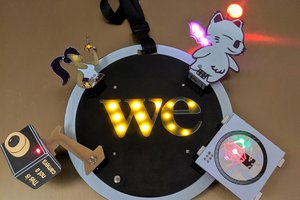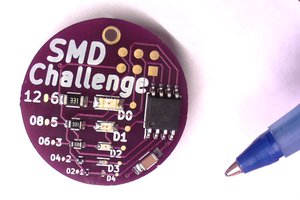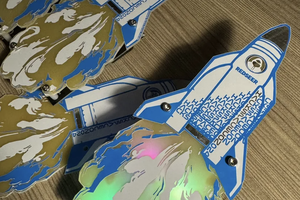Hardware
- Attiny85
- Orange 3mm LED’s x2
- 220 ohm resistors x2
- CR2032 battery holder
- CR2032 battery
- SMD 2 pin button
- 3 pin switch
Its a super simple circuit that’s more of a visual hack than anything else. I quickly breadboarded up the attiny85 with 2 LED’s and a button to just check that I was using the right pins on the attiny85 (I wanted PWM).
I asked my daughter to draw the outline of a pumpkin for the edge cuts and then on another layer and to do the face and other details which would be the silk screen on a different layer. I found it was best to export each layer as a jpeg. For full details on how to do this I’ve written up a blog post HERE.
I decided to use two 3mm LED’s one for each eye, I also added a button to that I would be able to switch between different LED modes. I kept it simple with the power, I powered it with a CR2032 coin cell. What I like about the attiny85 is that it can be powered from 2.7v-5.5v so a coin cell is more then adequate for the job. I decide to make this a wearable, I could have added a hole so it would go into a lanyard but I went the route of wearing it on a t-shirt/shirt as a badge. The good thing about using a coin cell on the back of the badge is that I could put a magnet under your t-shirt/shirt and stick it to the coin cell.
As this was going to be a soldering kit it had to be easy to solder, This is why I went with a dip8 version of the Attiny85 but it did take away from the aesthetics a little. I also went with thought hole resistors too. Too save ruining the aesthetics too much I went with a SMD button. For the switch I used a thought hole switch but on a SMD footprint but instead of putting it at the edge of the board like I normally do I put it in from the edge, I had to bend the pins for it to fit but I think it worked out quite well unfortunately it was a pain to solder.
To program the badge I used my pogo pin backpack programmer and a tinyUSB with the arduino IDE so it was easy to fix any errors while testing.
Software
I took the code from a very old project from 2013 HERE. I had to port it to the Attiny85 and I was only using 2 LED’s but it was easy enough to do. I will post the ported code below along with all the board files to go along with it.
 facelessloser
facelessloser
 Corey Benn
Corey Benn
 davedarko
davedarko
 MakersBox
MakersBox
 awkward intelligence
awkward intelligence